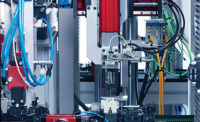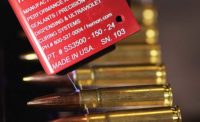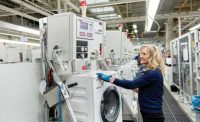Of the many steps in the process of assembling a wire harness, testing the crimped terminal is a crucial one. If the terminal hasn’t been properly attached to the end of the wire, it can cause the wire and eventually the entire wire harness to fail. Most manufacturers use pull testing to assess crimped connections and ensure that terminals are properly attached.
Pull testing measures the amount of tensile force required to separate a crimped terminal from a wire. To minimize the chance of product failure, it should take a good amount of force to do that.
According to Bob Hashoika, marketing manager at Imada, wire pull testers consist of three components: the gauge, which includes the load sensor, the test stand and the gripping attachment.
To perform the test, one end of a wire is fed into the gripping attachment, while the other end is secured to a fixed point. The tester then pulls the wire at a gradual pace, increasing the force until the wire breaks or the terminal is removed.
How fast the wire is pulled depends on the wire, the terminal and the application standard. For example, USCAR specifies that wire should be pulled at a rate of 50 to 250 millimeters per minute.
The tester records the amount of force required to remove the terminal. By pulling the wire at a constant rate, the tester can pinpoint the peak force required to remove the terminal from the wire.
A crimped connection is considered OK if the terminal is removed at a force that the company has determined is acceptable for the intended application. Again, this varies depending on the terminal and the size of the wire. Less force is needed to pull a terminal from a thin wire than a thick one. For example, according to UL standard 486A, it should take 1.5 pounds of force to pull a terminal from a 30 AWG wire, while it takes 70 pounds of force to pull a terminal from a 12 AWG wire.
Pull-force testing data can help manufacturers to properly calibrate the crimping tool, by providing data on the strength of the connection and any damage that may have occurred in the crimping process.
Manual vs. Motorized Testing
This process can be completed manually or with motorized testers. Mark Fridman, president of Mark-10 Corp., explains there are benefits to both manual and motorized testing.
“Motorized pull testing eliminates human error by offering a consistent test speed and force application,” says Fridman.
Manual pull-force testing is completed using a lever or hand wheel to apply force to the terminal. Hashoika explains that manual testing relies on an operator to provide consistent force every time. This can be difficult to achieve when multiple people are operating the tester. Each individual may use a different speed to apply the force and then may also apply inconsistent force from one terminal to the next.
“Motorized testing allows for very specific speeds, including half speeds, to be controlled as well as the amount of force applied,” says Hashoika.
This isn’t to say that manual pull testing doesn’t produce accurate results. Manual pull-force tests may be a better option for certain wire gauges. A number of organizations have established guidelines for specific wire gauges and applications. These include UL, ASTM International, NASA and the United States Council for Automotive Research. Some manufacturers, such as Volkswagen, have their own guidelines.
These guidelines provide a range or a minimum force that a terminal must withstand for it to pass the pull-force testing. Mark-10 suggests that its customers use the UL guide for minimum force requirements. Manufacturers can choose to do their own quality testing to determine the passing result for pull-force testing, however they should also be aware of industry and application specific requirements.
Pull-force testing is a destructive testing method, as it requires the terminal to be completely removed or the wire to break in the process. For this reason, most manufacturers will choose batch testing. How many wires to test will vary, depending on the application. One standard recommends a minimum of five pull-force measurements should be done to confirm each setup of the crimping press. After that, a minimum of 25 readings should be taken to monitor process capability.
There are nondestructive testing methods that can be used on every wire. These are similar to pull-force testing in that force is applied to the terminal connection. However, in these tests, manufacturers are looking to see that the terminal isn’t destroyed at a minimum force.
The advantages to nondestructive pull testing is that every connection can be tested prior to being used in a wire harness. Fridman points out that the disadvantage to this type of testing is that it can be more costly. It requires more time and resources to test every wire, rather than destructive batch testing. This testing method would require motorized testers that have more control over applied force and speed.
Common Errors
A number of errors can occur in pull-force testing. Prior to testing, the terminal could have been attached in a way that damaged the wire. Fridman explains that this can cause a false passing result, as it will require the designated amount or more force to remove the terminal, while the wire may have been cut so that it will not function properly.
In testing, application of force and the speed of the application are specific to the gauge of wire and the application. In manual application, a user can apply force too quickly, which can cause a false failure. Hashoika explains that some manual users can cause the test to shock load the terminal, by applying too much force too quickly.
Other errors include using the wrong gripping or clamping attachments for the wire that is being tested. Fridman says that the wrong grips can cut or strip the wire, leading to a failed test. In other situations, the wrong grips can lead to the sample not being properly loaded into the motorized tester. If the wire isn’t properly loaded, then it can’t be properly tested.
Inaccurate results can also occur when the tester isn’t properly calibrated. Manufacturers can use the output data to monitor when the tester may need to be calibrated. Fridman suggests using certified weights to ensure that force is properly calibrated. This, along with general preventative maintenance, allows for consistent results.








